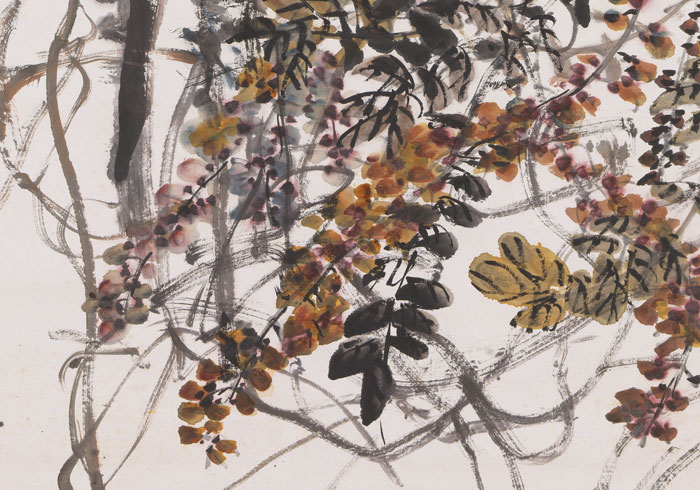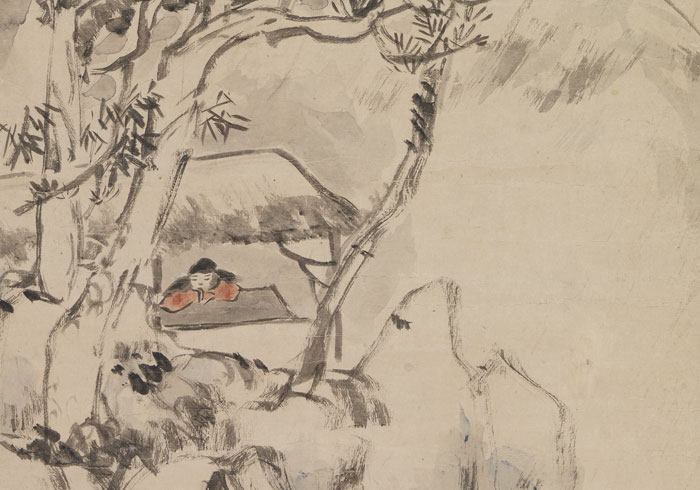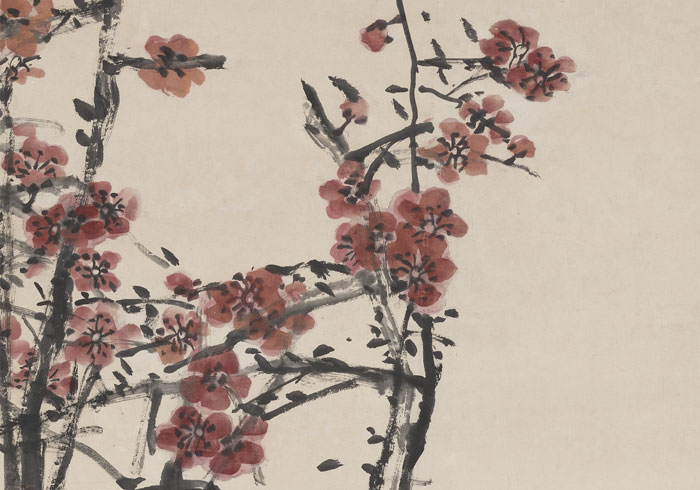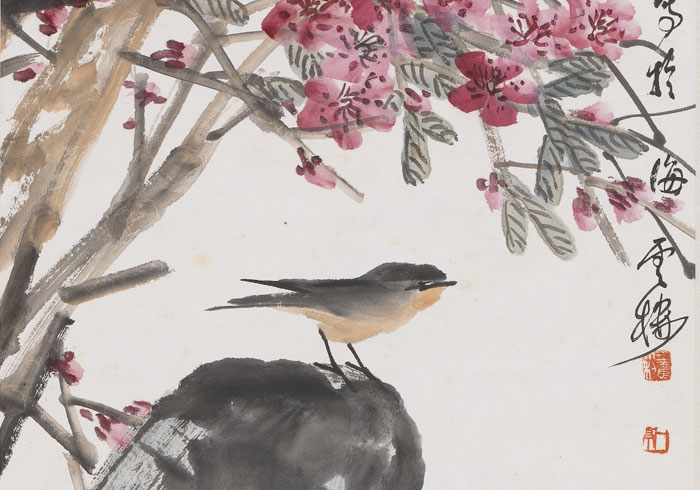Bronze-and-stele calligraphy rose in the nineteenth century and later spread to the art of painting. In the beginning, Wu Xizai was its pioneer and Wu Changshi its master who combined brushwork of the Northern Stele tradition and knifework in seal carving with painting to create a popular school in Shanghai art circles during the early Republican period. Wu Changshi, himself a native of Anji in Zhejiang, arrived in Shanghai for the first time around the age of thirty, receiving instruction in painting from Ren Yi before becoming a master in his own right. Wu's deliberately archaic awkwardness and hoary solidity in painting turned common subjects into elegant things, not only being fashionable at the time but also appreciated by Japanese as his appeal spread overseas. Wu moreover influenced following generations of artists in Shanghai, including Wang Zhen, and even inspired those who later achieved fame in Beijing, such as Qi Baishi and Chen Nian. This part of the exhibit features works by Wu and stylistically related artists, helping to trace the development of Bronze-and-Stele painting from the late Qing to the Republican period.
Wisteria Blossoms
- Wu Changshi (1844-1927), Republican period
- Hanging scroll, ink and colors on paper, 124.5 x 53 cm
Wu Changshi did this painting in 1924 at the age of 81 by Chinese reckoning. The sole subject is wisteria; besides the floral cones and leafy stems are winding vines that fill the composition, a characteristic of Wu's style in this type of work.
Starting in the middle of the Qing dynasty, the Bronze-and-Stele style of calligraphy flourished, and the simple but archaic and strong quality of engraved steles and bronze inscriptions from antiquity were used in calligraphy and seal carving. In these two art forms, Wu Changshi paid particular attention to the Bronze-and-Stele manner, his lines especially strong and bold as he successfully incorporated it into his paintings. This late work of his reveals large applications of the brush, its movement spirited and the composition skillfully conceived in a manner up to his standards.
Yuan An's Hut in Snow
- Wu Changshi (1844-1927), Republican period
- Hanging scroll, ink and light colors on paper, 65 x 33 cm
Wu Changshi, who did this work at the age of 49, depicted the story of Yuan An remaining at home in the snow. One day after a blizzard, people dug themselves out and began begging for food. Only Yuan remained lying at home, not wishing to burden the local prefect's rescue efforts. His determination and uprightness made him a paragon of moral excellence.
In the painting we see Yuan An wearing red. Although the thatched hut, trees, and rocks are done in a sketchy manner with a blunt-tipped brush, the glistening effect of accumulated snow is quite evident, an effect rarely seen in his works. This painting is dated to the equivalent of 1892, not long after Wu Changshi had moved to Shanghai. He inscribed it with the following lines: "I may appear almost as poor as Yuan An, but I sing my heart as a step into the snow not stiff from the cold." He makes a self-deprecatory contrast to say that he needs to scramble and make a living by painting, as opposed to the lofty integrity of Yuan An, in the process also demonstrating a sense of humor.
Red Plum Blossoms
- Wu Changshi (1844-1927), Qing dynasty
- Hanging scroll, ink and colors on paper, 129 x 62.1 cm
In the highly westernized and commercialized city of Shanghai, Wu Changshi's strong Chinese style in painting was highly admired, scholars and businessmen alike serving as potential customers. In addition to producing works that met the demands of the art market and popular taste, Wu often cited traditional Chinese painting in his dialogue with the past.
When Wu Changshi was invited to a banquet one day, he happened to see a painting of red plum blossoms by Luo Ping (1733-1799), the lofty and strong archaism inspiring him to make a copy from memory for Zhang Xiong (1803-1886). Wu was 81 at the time, but Zhang Xiong had already passed away many years previously, demonstrating the depth of their friendship. The bold composition here is balanced by the lengthy inscription, the branches rendered with mature brushwork in a marvelous manner.
Peach Blossoms and a Flock of Swallows
- Wang Zhen (1867-1938), Republican period
- Hanging scroll, ink and colors on paper, 138 x 33.6 cm
Wang Zhen was not only involved in business but also politics. He joined the Tongmenghui resistance movement in the late Qing and took part in revolutionary activities. After the establishment of the Republic of China, he encountered frustration with the political climate and announced his retirement from politics in 1913, afterwards delving into the arts and philanthropic activities. At about the same time, he formed a friendship with Wu Changshi. With Wang's many years of experience and contacts in the business world, he successfully introduced Wu's style to his Japanese friends, promoting Wu as a leading figure in Shanghai painting circles.
Wang Zhen did this painting in 1925 on the subject of a line of poetry from "Joy of Reading in the Four Seasons" by Weng Sen of the Yuan dynasty: "Flowers on the water's surface all form writing." By the water is a peach tree and a garden rock, the swallows and peach blossoms on the rippled water forming an interesting combination.




